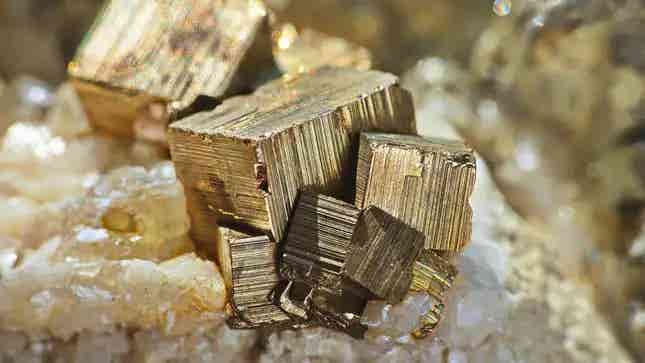Fool’s gold (Pyrite) could be the key to a clean energy revolution
Organic-rich shale may offer increased potential for lithium recovery due to the unique interaction between lithium and pyrite.

Airlines strictly forbid passengers from stowing laptops in checked luggage due to the inherent danger posed by lithium-ion batteries. Why? Because lithium, a key component of these batteries, is highly reactive. When exposed to water, pure lithium reacts violently, emitting heat and generating flammable hydrogen.
Despite its volatile nature, lithium's reactivity makes it an ideal candidate for battery production, playing a crucial role in the transition to green energy. Lithium-ion batteries not only power electric vehicles but also store energy from renewable sources like solar and wind.
The demand for lithium has surged in recent years. While primary sources such as pegmatites and volcanic clays are well-understood, discovering additional safe and economically viable lithium deposits would be advantageous.
Addressing this challenge, a team led by researchers from West Virginia University is investigating whether past industrial activities, such as mining operations or drilling activities, could offer untapped lithium reservoirs without generating new waste.
Shailee Bhattacharya, a sedimentary geochemist and doctoral student collaborating with Professor Shikha Sharma in the IsoBioGeM Lab at West Virginia University, will unveil the team's discoveries at the European Geosciences Union (EGU) General Assembly 2024.
Their study focuses on 15 middle-Devonian sedimentary rock samples sourced from the Appalachian basin in the U.S. Remarkably, the team detected abundant lithium in pyrite minerals within shale, a phenomenon deemed unprecedented by Bhattacharya.
Related Stories:
"While the geological literature lacked information on the nexus between lithium and sulfur-rich pyrite," Bhattacharya explained. "The electrochemical and engineering communities have already begun exploring the potential of lithium-sulfur batteries as alternatives to lithium-ion ones. My research aims to comprehend the association between lithium and pyrite."
Interestingly, organic-rich shale may offer increased potential for lithium recovery due to the unique interaction between lithium and pyrite. However, the generalizability of these observations beyond the current study site remains uncertain.
Bhattacharya cautioned that the study is site-specific, yet expressed optimism about its implications. This research hints at the prospect of certain shales serving as lithium sources without necessitating new mining endeavors, potentially advancing sustainable energy initiatives while conserving valuable resources.
The investigation sheds light on the dual nature of lithium: its hazards as a fire-prone element in batteries, and its promise as a vital component in the pursuit of sustainable energy solutions.
As the world seeks to reduce reliance on fossil fuels and embrace cleaner energy alternatives, understanding the intricacies of lithium's behavior and identifying novel sources becomes increasingly imperative.
Through collaborative efforts between academia, industry, and policymakers, the path towards a greener future powered by lithium may be within reach.
To learn more about this work, the poster presentation will be during ERE4.8 at EGU 2024.
For more science news stories check out our New Discoveries section at The Brighter Side of News.
Note: Materials provided above by The Brighter Side of News. Content may be edited for style and length.
Like these kind of feel good stories? Get the Brighter Side of News' newsletter.
Joseph Shavit
Head Science News Writer | Communicating Innovation & Discovery
Based in Los Angeles, Joseph Shavit is an accomplished science journalist, head science news writer and co-founder at The Brighter Side of News, where he translates cutting-edge discoveries into compelling stories for a broad audience. With a strong background spanning science, business, product management, media leadership, and entrepreneurship, Joseph brings a unique perspective to science communication. His expertise allows him to uncover the intersection of technological advancements and market potential, shedding light on how groundbreaking research evolves into transformative products and industries.



